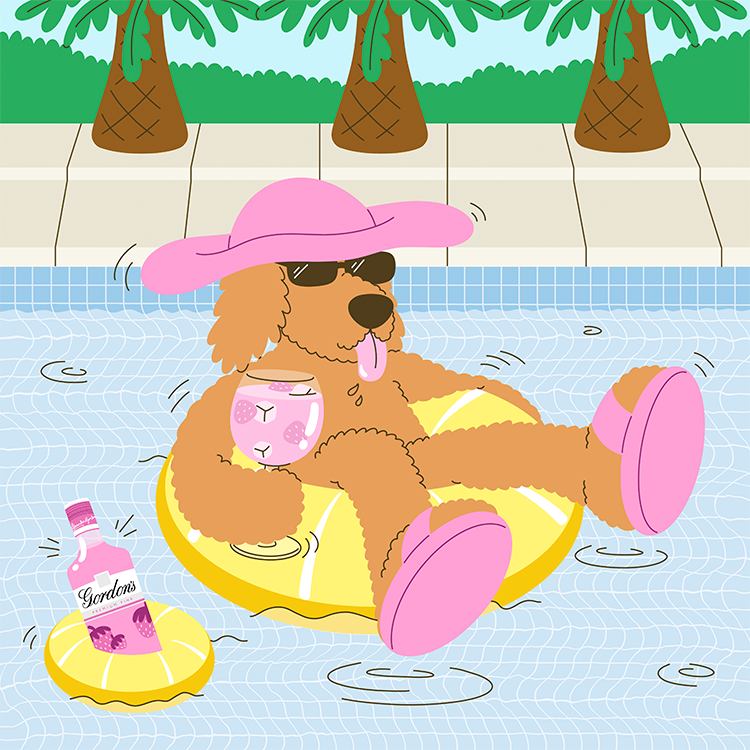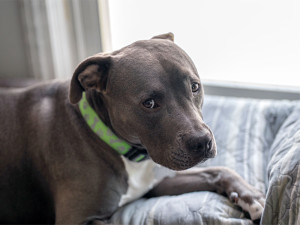Anthropomorphizing Your Pets Can Actually Benefit Them—and You
If your friends make fun of you for treating your dog like a human being, send them this.

Share Article
As a loyal pet parent, family reunions have always been a frustrating experience — not for me, but for everybody else involved. Coming from a long line of Irish Catholics, most of my relatives seem singlehandedly committed to furthering the world’s overpopulation. While they all share photos and stories of their children learning to walk and talk, I feel compelled to detail my dog’s (aka my baby’s) latest activities.
I’ll chime into conversations like, “Bedtimes really are so tough for us parents; if Banshee doesn’t get her regular 15 hours she becomes such a brat.” Or, “I know, she can’t sleep without her favorite blanket, either.” That sort of thing.
My cousins (present at previously mentioned family reunions), call this behavior of mine “annoying,” but to veterinary professionals, this is known as “anthropomorphism” — the act of attributing human characteristics to animals. Now, I’d argue my dog and I have a lot more in common than not. For example, neither of us can pronounce — or spell without the help of AI — anthropomorphize.
But when I suggest she feels guilty for having an accident in the house, the pros tell me this is textbook anthropomorphism. Thankfully, for my continued happiness and barely surviving sanity, these same experts confirm that this common pet-parenting practice can do more good than bad for our cats and dogs. In fact, it might even make us better pet parents overall.

Why do we anthropomorphize our animals?
“It’s really common for people to anthropomorphize their pets, because pets are such an important part of our lives, and it’s a way that people can find connection with their pets,” explains Dr. Valli Parthasarathyopens in new tab, a veterinary behaviorist and co-founder of Synergy Veterinary Behavioropens in new tab. We humans are gifted with — or burdened with if you’re a supervillain — the capacity for empathy.
Unless they’ve been convicted of something truly horrible or are a fan of the New England Patriots, we generally want to know how others are feeling and if they’re happy — human or not. It’s the motivation behind every cartoon with animals, including Mickey Mouse, and even the Cheetos mascot. Heck, the movie that introduced the world to colorized film, The Wizard of Oz, effectively boils down to exploring the emotions of lions, scarecrows, and tins of oil.
Susan Nilson, trainer and founder of The Cat and Dog Houseopens in new tab, notes that this type of personality projection is a simple method for us to interpret our pets’ behaviors in a way we can relate to, even if our reading is always 100 percent correct. “Whether our interpretations are always accurate is another matter. But it’s natural for us to want to try to understand our pets through a human lens, as it’s the primary frame of reference we have,” she says.
How anthropomorphism improves pet parenting.
To be clear, there are plenty of examples of anthropomorphism that already have proven beneficial to our pets. Technically speaking, taking your dog for a walk in a stroller is a form of anthropomorphism because you’re treating them as a human baby. Especially for senior pups or those who struggle with mobility, this can provide many of the same boons as standard walks, minus the exercise. While human parents might roll their eyes when we say our cat looks angry or our dog looks upset, there is evidence to support that they might actually be trying to express these emotions.
“Research shows that dogs have evolved to use certain facial expressions, such as raising their inner eyebrows, to mimic the type of expression humans associate with being sad,” Nilson says. She also explains that when dogs do this, their eyes may appear larger and more infant-like, which automatically triggers our human protective instincts. Over time, pups pick up on this response, so it helps them communicate and evoke certain responses from us.
Anthropomorphizing pets may actually help pet parents communicate with them, rather than just being a thing kooky thing we do when we’re bored (as valid as that is). For their part, our pets may learn to use our anthropomorphic habits as a means of language. When your pet gives you those classic puppy-dog eyes, you might respond in an overly attentive way because you’re assuming they’re sad or afraid. They’ll then quickly realize that face or that expression elicits a certain response, so the next time they want that reply, they’ll shoot you the same doe-eyed look.
“The dogs learn that when they give this certain look, they get attention because they are social so different dogs learn different ways to ask for attention,” Dr. Parthasarathy says. She then equates this strategy to the same way humans communicate similar ideas. “Just like people, if they live with somebody, they’re going to go up and say, ‘Hey, I want to chat with you,’ or ‘Let’s hang out on the couch together.’ Dogs need to figure out their own ways within their family to make those same requests,” she adds.
Anthropomorphism strengthens the human-pet bond
Beyond enhancing your ability to communicate with them, imprinting human characteristics onto dogs and cats can also have other subtle positive impacts. While you (read: me) spend the majority of your day staring at your pet imagining what they might be thinking and performing their presumptive inner monologue, you’re unintentionally giving them a chemical boost.
We also know that mutual gazing between pets and their owners can lead to increased levels of oxytocin, a hormone associated with bonding and trust. So, when your dog, cat, or bunny is giving you those puppy-dog eyes, you are building a stronger mutual connection without even realizing,” Nilson says.
Attributing human feelings and attitudes onto our pets can equally help us better empathize with them. No matter how much we love our pets, most of us are not experts in canine or feline behavior, so Nilson points to anthropomorphizing as a way to improve our understanding. She adds, “By recognizing that our pets are sentient beings with complex emotions, we may be more motivated to provide them with the best care possible and show greater empathy.”
In a way, Dr. Parthasarathy has regularly encouraged this type of thinking with pets under certain circumstances at her practice. She explains that when patients come in, they’re often experiencing varying levels of stress, anxiety, or fear. One way to console them is through helping them better understand their pet’s emotions in that moment.
“I’ll often tell clients, ‘Imagine that you’re in your dog’s position or imagine that you’re in your cat’s position and how you would feel if this sort of situation came up,’” Dr. Parthasarathy says. “So, helping them start to understand that this is how their pet is likely feeling can help with empathy and can also help them become closer to their pet as well.”
There are some possible cons to treating your pet as a human being.
Of course, there is always the risk of misunderstanding what your animal is attempting to communicate. Assigning the wrong emotions or needs onto pets here can result in less-than-ideal outcomes.
As Nilson puts it, “By attributing human-like thoughts and feelings to animals, we may completely miss the mark as to why they are engaging in a particular behavior. This can result in miscommunication and misunderstanding, leading to misguided training techniques or even ignoring important health concerns.”
She uses the example of a dog ripping up a couch and their people assuming they did it out of spite for being left alone for too long. This common form of anthropomorphism ignores clear signs of separation anxiety; therefore these pet parents will likely fail to address the condition properly.
Similarly, if you infer that your dog is feeling guilty after having an accident in the house, it’ll be easy to avoid recognizing that they simply need more frequent bathroom breaks or that it’s time to revisit house training. Dr. Parthasarathy confirms that it’s not likely these animals are performing out of spite or guilt. In fact, they might not even be capable of emotions such as these. “The research suggests that dogs and cats are not doing things out of spite. Usually, if they’re doing behaviors like this it’s due to anxiety, panic, or a medical condition,” she says.
In most cases, Dr. Parthasarathy stresses the importance of context over the use of anthropomorphism. Sometimes, when a dog looks guilty or upset, they’re merely acting in the way they’ve learned you want them to after previous incidents. When your pet trashes the house before you come home, they’ll look guilty not because they’re feeling shame — but because they know you’re upset.
“It’s an appeasement behavior. They are really good at reading body language and so they’re really good at predicting outcomes,” she explains. In other words, they probably have previously made the association between messing the house and getting yelled at. So, as you walk through the door, they might look guilty, but they’re really just preparing for a scolding.
What’s most important is using all of the information you have to objectively deduce what your pet is feeling, asking for, or in need of. “People have to understand what the animal is communicating and that what the animal is communicating or attempting to communicate may not be the same as what us humans think they’re communicating,” Dr. Parthasarathy says.

Sean Zucker
Sean Zucker is a writer whose work has been featured in Points In Case, The Daily Drunk, Posty, and WellWell. He has an adopted Pit Bull named Banshee whose work has been featured on the kitchen floor and whose behavioral issues rival his own.
Related articles
![]()
To Cry Is Human—and Apparently Canine
Time to whip out The Notebook for a little doggie movie night.
![Two happy Golden Retriever dogs sitting on the bed together]()
Do Dogs Have Besties?
They’re not exactly crafting friendship bracelets for each other, but dog bonds mean something.
![Portrait of a woman playing and having fun in the park with her big pet, a greyhound dog.]()
How’s Your Dog Feeling? Check Their Tail
If your dog’s tail is wagging “to the left, to the left,” as Beyoncé says, it could mean they’re anxious.
![Jack Russell puppy grunting while laying on blanket and crying out]()
Listen Up! Your Puppy Is Trying to Talk to You
How to make sense of all those grunts and whines.
![A woman sitting on a floor playing with her dogs.]()
How to Know if Your Dog Has Imprinted on You
If they’re following you around like your shadow, there’s a reason for that.
How to Tell If Your Dog Is a Hugger—Or Not
Boundaries, folks. Boundaries.
![A man in a blue t-shirt holding a super cute puppy against an orange background]()
Baby Face: The Allure of Cute Dogs
The evolutionary advantage of Kindchenschema for animals.










